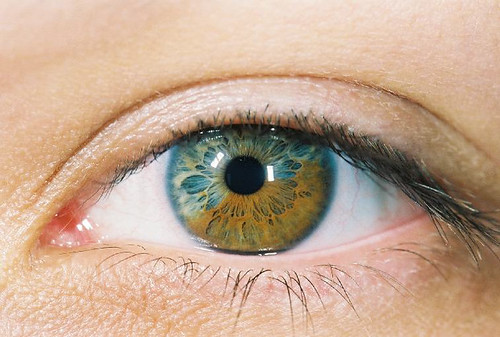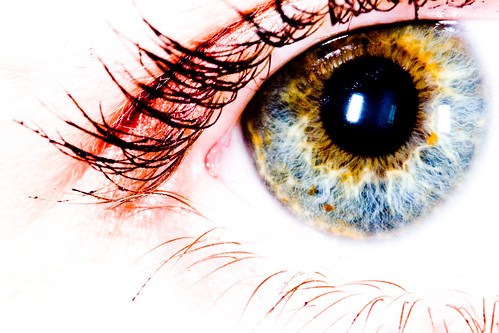
and:

Later, I paid more attention to aesthetics, and came up with images like this:

At any rate, the first of these photos recently garnered the question on flickr of which lens I had used, to which I responded (shown here with corrections):
This (and all my eye macro photos) was shot with a Canon 100mm f/2.8 Macro USM lens. There's a new L version of the lens out, which I haven't tried.
I've been using the Macro Twin-Lite MT-24EX flash, which mounts nicely directly onto the front of the lens. TheMR-12EXMR-14EX Macro Ring-Lite may actually provide better results for eye macros, though (I think the reflection is more likely (though perhaps not guaranteed) to land inside the pupil, thus leaving the Iris visible everywhere). (I got the Twin-Lite for general versatility reasons, even though eye macros were a major motivator.)
This particular shot was done on 35mm film (Fuji Velvia 50, I think), and others were shot digitally (with a 1.6x crop factor, which is visually quite different).
Also note: I haven't tried the 180mm macro lens, though I know some folks like it a lot (if not for this specific subject matter -- I don't know if they've tried it), and it can also be fitted (via an adapter) with the Ring and Twin Lite flashes. If you're doing try-before-you-buy, I'd try that lens, too.
Good luck!
The asker then asked a follow-up about where to find a "good deal" for finding such equipment, and further whether I had an opinion on the MP-E 65mm 1-5x Macro lens. I am now moving my reply to these questions here. This blog has long been in need of a next good question, and I realized this could be it.
So, to answer the follow-ups:
Ahh, yes, didn't think to mention that one. I've never actually tried it (though I've been meaning to, at some point), but from what I understand of it, it's certainly an option as well (and will also directly take either of those strobe options).
It sounds like your purposes may be medical in nature?
If so, I presume you have the advantage of a setup for keeping the subject's head still, which will be a huge advantage for you with any of these lenses. The main difference you'll find with the 65mm 1-5x is its ability to go to 5x, and the fact that it's ONLY usable for macro use (the others focus to infinity, the 1-5x just changes magnification, and focus is handled by moving the camera&lens towards or away from the subject -- or at least that's how I understand it). The depth of field at these distances is quite small with any of these lenses, so depending on your setup, the having-to-move-the-camera (in very small increments) may or may not prove difficult (typically a focusing rail is used for studio macro work -- in an ophthalmological setting, I'm imagining (with minimal actual knowledge) that you'd have some sort of swing-arm with the camera mounted on it? Or perhaps it would be something completely different. Either way, you'll want to make sure that whatever rig the camera is mounted on can be adjusted in very small increments towards or away from your subject (patient) to focus the image, and be quite stable when not being moved for that purpose, so as not to fall back out of focus. This is likely true with any of these lenses, but especially so with the 1x-5x, since it is without any other way to focus.
The other difference that I imagine will be relevant to you would be lens-to-subject distance. The longer the focal length of the lens, the longer this distance will be when the image is in focus (which may impact subject comfort -- though perhaps in your situation this is less of an issue, since they're expecting things close to them anyway?). So for the 65mm, you'll presumably have the least distance (I don't know how much, though, and it should be noted that there are other factors in determining this distance, having to do with how exactly the lens is constructed). With the 100mm at 1x magnification, I've found the distance to be approximately 6 inches. With the 180mm, it would be longer (apparently 9.5", according to this review).
There are also a number of other resources out there about this subject. Wikipedia's Macro photography article is probably a good general introduction.
Now, as for where to get a good deal, I must first say that buying from a local retailer -- especially a high-end specialty camera store (e.g. Glazer's in Seattle, where I happen to be) -- can often be worth a somewhat higher price than other options: what you loose in savings for the initial purchase can be more than made up for in service options for repairs (for example, Glazer's will ship things back to Canon for warranty service, I believe at no charge, when you bought the item from them), help from staff, etc. Of course, different stores are different, so your results may vary. It's worth considering, though.
If price is your most important thing, though, I've found that I tend to be able to get the lowest prices from online retailers (which seem to all be in New York, somehow) such as B&H, Adorama, or J&R. You'll want to be wary of retailers you haven't heard of (there are some fly-by-night operations out there, too, sadly). All three of those I've named I've had good experiences with, and I know they've been around for a while, so hopefully your experiences will be good as well. You could also shop from either a search-engine front end like Google Products, or an online retailer like Amazon.com (who also has the L version, of course, not to mention the MT-24EX Macro Twin-Lite and MR-14EX Macro Ring-Lite flashes) that also allows you to buy from other merchants (including, frequently, some or all of the ones I mentioned earlier).
Of course, there's nothing that says you have to go with the Canon. I'm only listing the Canon options, and particularly the 100mm, because that's what I happened to use, and that was the initial question. I know Nikon has macro options as well, not to mention 3rd-party lens manufacturers such as Tamron, or other makes such as Pentax or the like. I have little if any experience with these options, though, so I leave that to the reader.
If you have further questions, please post them either here or on flickr, and I'll be happy to add to this response.
Thanks for asking!

